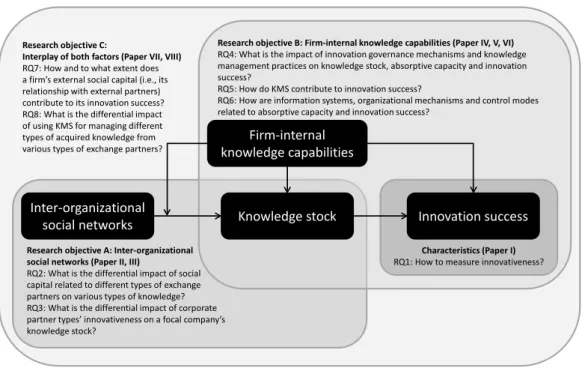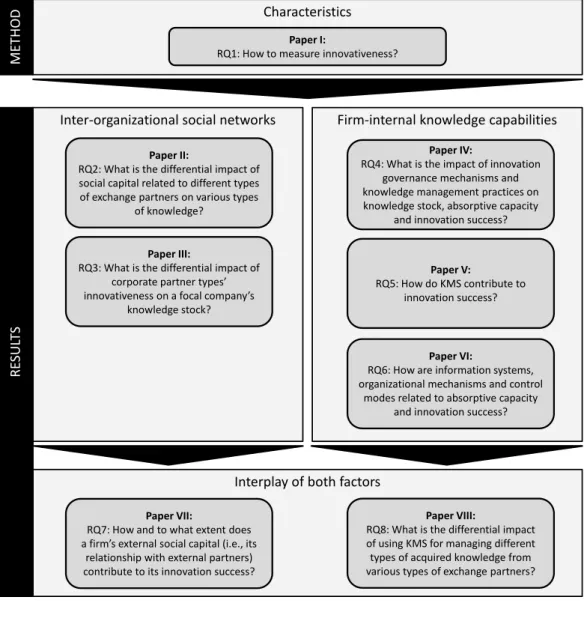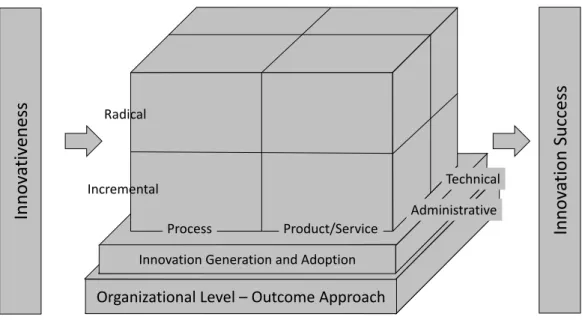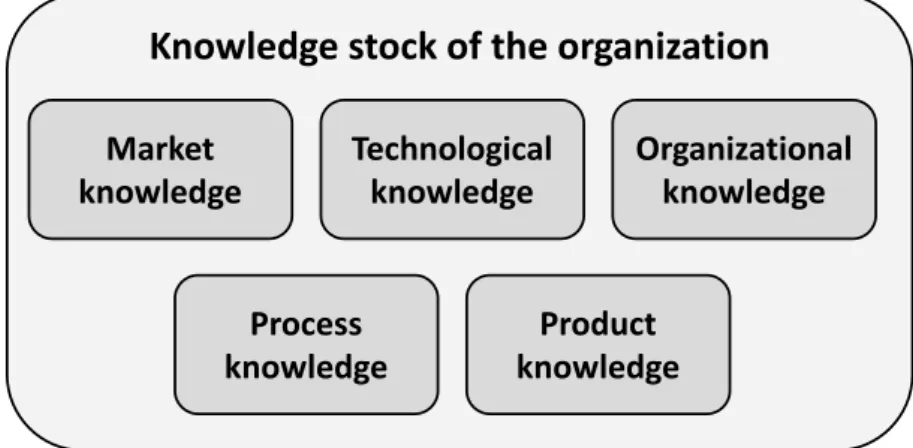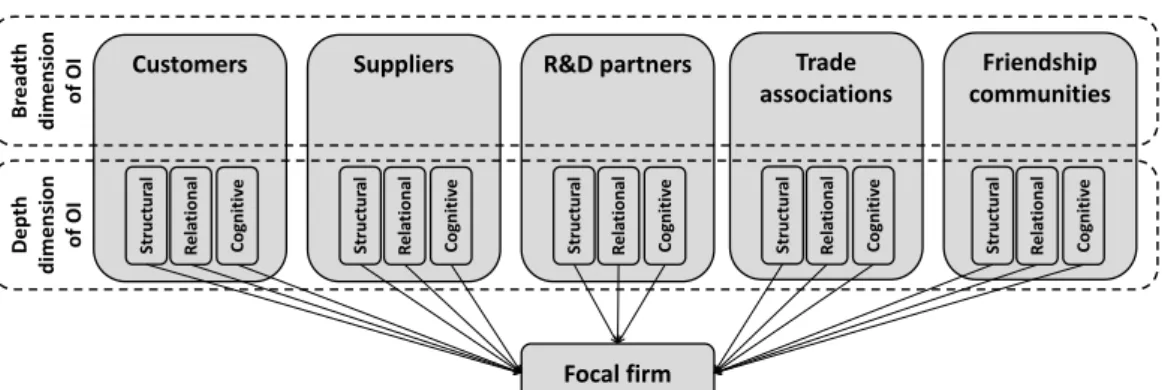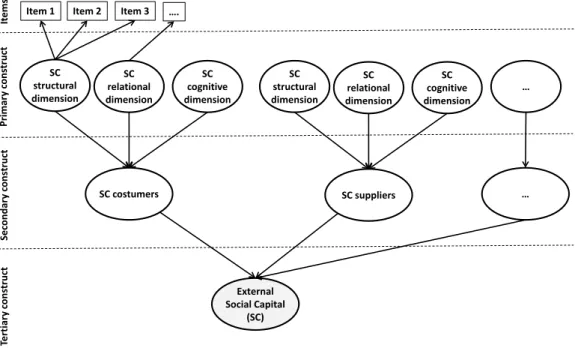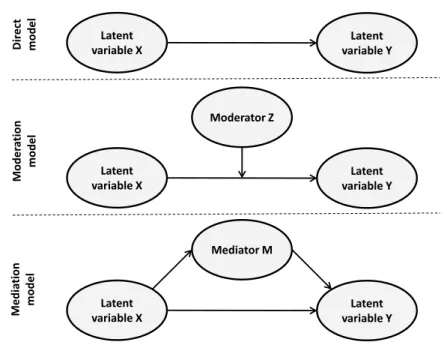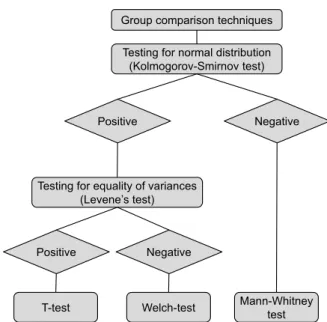The Role of External Social Networks and Internal Knowledge Capabilities for
Innovation Success
Bernhard Moos
2015
Diese Arbeit hat der Fakultät Wirtschaftsinformatik und Angewandte Informatik der Otto- Friedrich-Universität Bamberg als Dissertation vorgelegen.
1. Gutachter: Prof. Dr. Tim Weitzel
2. Gutachter: Prof. Dr. Heinz-Theo Wagner
Mitglied der Promotionskommission: Prof. Dr. Kai Fischbach
Tag der Disputation: 19.11.2014
Foreword by Prof. Dr. Tim Weitzel
Peter Drucker was fond of saying that “Innovation is the specific instrument of entrepre- neurship...the act that endows resources with a new capacity to create wealth.” But, to borrow the title of this thesis, what makes firms innovative?
Dr. Bernhard Moos takes a network perspective to tackle this eternal question. The network metaphor is widespread and probably among the most used images of the past century. Research on innovation diffusion networks, for instance in the marketing sci- ences or Information Systems literature, has become quite mature (e.g., Rogers 2003;
Weitzel et al. 2003). But creating sustainable firm-level innovativeness remains a tough theoretical and managerial challenge. There is no scarcity of observations that a firm’s innovativeness is related to the business network it is embedded in. The Economist writes that “Procter & Gamble tries to get half of its innovations from outside its own labs. Microsoft works closely with a network of 750,000 small companies around the world.” (Economist 2009). Yet transcending the multitude of singular observations into an embracing theoretical understanding that allows to suggest systematic innovation governance approaches and derive managerial interventions makes this book such a captivating read.
Embracing the extant literature on innovation and knowledge management, the theoret- ical core of the analysis is an explicit theoretical model of the interplay of the external network, operationalized as a firm’s social capital, and its internal knowledge capabili- ties, operationalized as a firm’s absorptive capacity. To the delight of Henry Ford, who was skeptical to rely on customers alone when looking for innovation (“If I had asked my customers what they wanted, they would have said faster horses”), Dr. Moos looks for the sources of innovativeness in a firm’s network neighborhood that consists of vertical (customers and suppliers), horizontal (trade associations) and lateral partners (R&D partners) and also individual-level accidental relationships (friendship communities).
This is a challenging endeavor. But Dr. Moos succeeds in developing a theoretically and empirically convincing innovativeness model that is both intellectually challenging and managerially useful. Among others, he can show that, indeed, innovativeness is conta- gious (Moos et al. forthcoming), that besides customers R&D partners in particular can be valuable sources of different types of knowledge and how Knowledge Management Systems support innovativeness (Moos et al. 2013).
Gary Hamel remarked that “(m)ost of us understand that innovation is enormously im- portant. It's the only insurance against irrelevance. It's the only guarantee of long-term customer loyalty. It's the only strategy for out-performing a dismal economy.” This book is a must-read for anyone interested in innovation research and how a firm can keep on
innovating to design the future. After all, none other than Gene Roddenberry suggested
“It isn't all over; everything has not been invented; the human adventure is just begin- ning.”
Prof. Dr. Tim Weitzel (Bamberg, March 2015)
References
Economist (2009). Global Heroes.
http://www.economist.com/specialreports/displaystory.cfm?story_id=13216025, Mar 12th 2009.
Moos, B., Beimborn, D., Wagner, H.-T., and Weitzel, T. (2013). The Role of Knowledge Management Systems for Innovation: An Absorptive Capacity Perspective.
International Journal of Innovation Management, 17(05), 1350019.
Moos, B., Wagner, H.-T., Beimborn, D., and Weitzel, T. (forthcoming). The Contagious Power of Innovativeness: How Different Corporate Partners Contribute to a Firm's Knowledge. International Journal of Innovation Management.
Rogers E.M. (2003). Diffusion of innovations. Simon & Schuster Ltd: London.
Weitzel, T., Wendt, O., von Westarp, F., and König, W. (2003). Network Effects and Diffusion Theory - Extending Economic Network Analysis. The International Journal of IT Standards & Standardization Research, 1(2), pp. 1-21.
Foreword by Prof. Dr. Heinz-Theo Wagner
Innovation is a topic that gains significant interest in academia and practice alike. Inno- vation is crucial in most industries and seen as a distinguishing driver of firms’ growth, competitiveness, and organizational survival. Innovation is therefore a relevant object for strategic considerations including internationalization of research and development, and open innovation. Correspondingly, expenditure for innovation-related activities such as research and development accounts for large parts of the investment budget of firms.
These investments are related to the high expectations and hopes regarding the value innovation activities are supposed to deliver. Consequently, researchers have investi- gated the antecedents, nature, and effects of innovation and produce an increasing number of publications in top journals. Key insights over decades of innovation research reveal that a firm’s knowledge stock as well as a firm’s ability to manage knowledge are at the heart of innovation and are seen as strategic resources.
But, despite decades of academic research and acknowledging the importance of knowledge and its exchange and recombination for most companies, the sources of in- novation success is the subject of debate and controversy in theory and practice for many years now. In this respect, the connection between networks and a firm’s innova- tive capabilities plays a central role in research and has been addressed by a number of studies. However, our understanding how a firm might benefit from its external network is limited. In particular, mainly one open issue can be identified: the unclear interplay of external networks and firm-internal capabilities and their differential effect on innovation success.
Reflecting this challenge, the thesis of Dr. Bernhard Moos aims at theoretically evaluat- ing and empirically validating what makes a firm innovative. Corresponding to the chal- lenging task of his thesis, Dr. Bernhard Moos analyzes recent research on networks, knowledge and the ability to manage knowledge. The author builds his work on an orig- inal combination of the absorptive capacity and social capital theory, applied at an or- ganizational level of analysis and focusing on the interactions between a focal firm and its network. This approach has found only slight attention in most parts of the literature so far. The procedure makes it evident which factors in which constellation contribute to the innovativeness of firms and to the acquisition of market advantages. To validate the relationship between the various factors and innovativeness, an empirical study among Germany’s top 2,500 manufacturing companies was conducted.
This unique combination enables Dr. Bernhard Moos, and from now on also the scien- tific community, to more clearly understand the interplay of firm-internal knowledge ca-
pabilities and a firm’s external network. The work captivates by its methodologically elaborate and clear structure that fully meets the requirements of current research literature and by the sound analysis of a large number of evaluated literature contribu- tions. Furthermore, the quality of collected data, the test of numerous hypotheses, and the combination of model building and a survey within this cumulative dissertation is exceptionally remarkable, contributing to an improved understanding of a firm’s innova- tiveness and offering great building blocks for further research to the scientific communi- ty.
The research results of Dr. Bernhard Moos provide a solid fundament to a more sophis- ticated understanding of the transmission process from firm-internal knowledge capabili- ties and external networks to innovation success. This dissertation is a must read for anyone who is interested in the innovativeness of firms as it identifies the interplay of internal and external factors and its influence on innovation success, and provides valuable concepts of how to manage the innovation arena.
Prof. Dr. Heinz-Theo Wagner (Heilbronn, March 2015)
Acknowledgements
Without the support of my supervisors and mentors, my PhD committee, colleagues, friends, and family this dissertation thesis would not have been possible. Therefore I would like to acknowledge the support which they gave me throughout this project, though I am very much aware that these words do not do justice to the extent of my gratitude.
First of all, I cannot find enough words to express my thanks to my academic advisor Prof. Dr. Tim Weitzel and to Prof. Dr. Heinz-Theo Wagner for serving as a co-referee, who both continuously supported and guided me during the completion of this disserta- tion. Together, they offered an extraordinary working environment by setting up a crea- tive and inspiring cooperation project between the University of Bamberg and the Ger- man Graduate School of Management and Law in Heilbronn. Furthermore I would like to thank Tim and Heinz-Theo for their instructive support regarding my publication ef- forts as unfailingly they each made time for me when I needed their advice in general or on specific topics. Without their guidance, persistent help, and stimulating discussions this dissertation would not have been possible.
It is also with deep gratitude that I acknowledge the support of Prof. Dr. Kai Fischbach, the third member of my PhD committee, for his valuable time, for sharing his ideas and interest, and for his keen advice on my research.
I also owe an immense debt of gratitude to my diploma degree advisor, Prof. Dr. Daniel Beimborn, for convincing me to continue my research at the doctoral level. During the PhD process, Daniel has become both an excellent partner for discussing and publish- ing our respective work as well as a very good friend. I am very grateful that I could al- ways count on him no matter what the problem was and that I had the opportunity to spend so much time together with him over the last years. His constant support from the beginning until the end and his hugely constructive comments added to and enhanced the contribution of my dissertation and made it all possible.
Moreover, I feel especially indebted to Dr. Nils Joachim, Dr. Sven Laumer, Dr. Christian Maier, Dr. André Schäfferling, Frank Schlosser, and Alexander von Stetten, not only as former colleagues but also as friends. With Nils, Christian, and André I spent many hours discussing methodological issues, while Frank shared his experiences regarding large-scale empirical surveys. I treasure the research on outsourcing undertaken with Alex and I would like to say thank you for the countless funny stories we shared during our joint lunch breaks. I also wish to offer thanks to Sven for his instructive support es- pecially when finalizing this dissertation. Besides our numerous discussions and joint publications, I also enjoyed the conferences we attended together, and I am very grate-
ful for the time spent with all of you which I will never forget. Thank you very much for your invaluable help and the great fun we had. It was a pleasure for me to be part of such a great team.
In addition, I want to say thank you to my friends and colleagues Steffen Illig, Christian Jentsch, Janina Kettenbohrer, Dr. Björn Münstermann, Diana Renner, Andreas Schil- ling, Christoph Weinert, Dr. Anna Wiesinger, Udo Wild, Jakob Wirth, Thomas Wirtky, and Dr. Katja Zolper for our common work in several projects, for supporting my work and for being an excellent team that I always enjoyed working with.
I would like express my immense appreciation to our secretary Gudrun Stilkerich at the University of Bamberg as well as to Prof. Dr. Tomás Bayon, Peter Hochlehnert, Anja Köhler, and Ute Wachs at the German Graduate School of Management and Law in Heilbronn. Without their assistance, promptness, and flexibility, many processes would not have gone as smoothly as they did.
Finally, I owe my deepest gratitude to my family. Special thanks go to my beloved parents, Regina and Georg, who opened the way for me to receive an excellent educa- tion and convinced me that I could accomplish this goal. Furthermore I am very grateful to my dear sister, Larissa, and my parents in law, Martina and Michael, for encouraging me throughout my dissertation. Finally, and in particular, I want to thank the most important person in my life, my wife Katrin, who paid a high price for my dissertation.
She allowed me to have lots of free space, has shown infinite understanding, and always believed in me. I am thankful for her emotional support and for the time and effort she spent keeping me steadfast until the end. Life is wonderful with you.
Bernhard Moos (Bamberg, March 2015)
Zusammenfassung
Innovationen, verstanden als eine einzigartige und superiore Kombination von Wissen, verschaffen einem innovierenden Unternehmen einen Vorsprung gegenüber dessen Wettbewerbern (Schumpeter 1934) und tragen somit zum Fortbestehen eines Unter- nehmens am Markt durch dessen evolutionäre Fitness bei (Crossan and Apaydin 2010).
Folglich ist das kontinuierliche Innovieren für den Markterfolg eines Unternehmens un- abdingbar (Schumpeter 1934), wobei diesem zur Schaffung von Innovationen drei Stra- tegien zur Verfügung stehen: Reine unternehmensinterne Forschung und Entwicklung, reiner Bezug von externen Technologien oder eine Kombination beider Strategien (Cassiman and Veugelers 2006). Speziell letztere erweist sich als erfolgversprechends- te Strategie (Cassiman and Veugelers 2006). Dies liegt mitunter an dem heutigen hoch kompetitiven Wettbewerbsumfeld und an dem hohen Technologiegrad der Produkte und Prozesse eines Unternehmens, so dass das unternehmensintern vorhandene Wis- sen zur Schaffung von Innovationen meist nicht ausreicht und somit um unternehmens- externes Wissen ergänzt werden muss (Berchicci 2013; Cassiman and Veugelers 2006). Dementsprechend hat in jüngster Vergangenheit innerhalb der Unternehmen ein Wandel von einer monolithischen Struktur der reinen unternehmensinternen Forschung und Entwicklung hin zu einer offenen Struktur stattgefunden, welche es Unternehmen erlaubt, externe Wissensquellen aktiv in den Innovationsprozess mit einzubinden (Berchicci 2013). Diese Vorgehensweise zur Schaffung von Innovationen wird als Open Innovation bezeichnet und geht auf Chesbrough (2003) zurück.
Während sich die ersten Arbeiten zu Open Innovation und interorganisationalem Wis- senstransfer primär auf den reinen Wissensaustausch konzentrierten, fordern jüngere Arbeiten eine weiter gefasste Perspektive, welche die unternehmensinterne Integration und Transformation des extern erworbenen Wissens zur Schaffung von Innovationen berücksichtigt (Easterby-Smith et al. 2008). Der zu Grunde liegende Gedanke, welcher auch gleichzeitig eine Leithypothese dieser Arbeit ist, ist der, dass ein Unternehmen nur mit Hilfe von unternehmensinternen Wissensverarbeitungsfähigkeiten in der Lage ist, von seinem Netzwerk verstanden als Quelle für innovationsrelevantes Wissen zu profi- tieren (Fosfuri and Tribo 2008; Salge et al. 2012). Diese internen Fähigkeiten wurden aber bislang nur unzureichend betrachtet (Huizingh 2011), so dass der Ruf nach deren theoretischen und empirischen Untersuchung vermehrt aufkam (Lichtenthaler 2011).
Diese Dissertation nimmt sich diesem Ruf an und untersucht neben der detaillierten Be- trachtung von interorganisationalen Netzwerken und unternehmensinternen Wissens- verarbeitungsfähigkeiten auch deren wechselseitige Beziehung zur Generierung von Innovationserfolg. Entsprechend werden drei konkrete Forschungsziele verfolgt:
• Interorganisationale Netzwerke: Wie beeinflusst ein mehrere Partnertypen umfassendes interorganisationales Netzwerk den unternehmerischen Wissens- stand?
• Unternehmensinterne Wissensverarbeitungsfähigkeiten: Wie und in wel- chem Ausmaß tragen unternehmensinterne Wissensverarbeitungsfähigkeiten zur Generierung von Innovationserfolg bei?
• Zusammenspiel beider Faktoren: Wie spielen interorganisationale Netzwerke und unternehmensinterne Wissensverarbeitungsfähigkeiten zur Generierung von Innovationserfolg zusammen?
Zur Beantwortung dieser Forschungsfragen werden acht meist veröffentlichte Artikel unter Verwendung eines empirisch-quantitativen Ansatzes herangezogen. Das Funda- ment für diesen Ansatz stellt eine Literaturrecherche dar, welche den bisherigen Stand des Wissens zur fragebogen-basierten Vermessung der Innovationsfähigkeit eines Unternehmens zusammenführt. Mit Hilfe dieser Erkenntnisse wurden Daten von 229 Unternehmen des deutschen produzierenden Gewerbes erhoben. Auf Grundlage dieser Daten wurden anschließend die unterschiedlichen Forschungsfragen unter Zuhilfenahme verschiedener theoretischer Konzepte, wie der Sozialkapitaltheorie (Nahapiet and Ghoshal 1998) oder den Konzepten der Aufnahme- und Umsetzungsfähigkeit – der sog.
„Absorptive Capacity“ (Cohen and Levinthal 1990) – sowie unter Verwendung von quanti- tativen Methoden insbesondere der Regressionsanalyse und der Strukturgleichungsmo- dellierung untersucht.
Besonders von Bedeutung für eine detaillierte Betrachtung des Effekts eines interorgani- sationalen Netzwerks auf den Wissensstand eines Unternehmens ist die Differenzierung des Netzwerks in verschiedene Partnertypen sowie die des Wissensstands in verschie- dene Wissensdomänen. Ein Unternehmensnetzwerk umfasst dabei die Partnertypen Kunden, Lieferanten, Entwicklungspartner, Verbände/Arbeitskreise und – als individuelle, persönliche Verbindung verstanden - außerberufliche Netzwerke der Mitarbeiter. Die individuellen Beziehungen des Unternehmens werden dabei mithilfe der Sozialkapitalthe- orie formal vermessen, was ein theoretischer Kern und Beitrag der vorliegenden Arbeit ist. Ferner wird der Wissensstand von den Wissensarten Marktwissen, Technologiewis- sen, organisatorisches Wissen, Prozess- und Produktwissen abhängig gemacht. Auf Basis dieser beiden Differenzierungen lassen sich detailliertere Aussagen im Vergleich zu bisherigen Arbeiten über den Beitrag externer Partner zum Wissensstand eines Unter- nehmens treffen, wobei dieser Beitrag nicht nur an der Beziehungsgüte zu den externen Partnern, sondern auch an der Innovativität der Partner ausgemacht wird.
Hinsichtlich der unternehmensinternen Wissensverarbeitungsfähigkeiten betrachtet diese Arbeit die Aufnahmefähigkeit (externes Wissen der Partner dem eigenen hinzufügen können) und Umsetzungsfähigkeit (den Wissenstand aus internem und externem
Wissen tatsächlich umsetzen können) sowie den Einsatz von Wissensmanagementsys- temen und die Ausübung einer Innovation-Governance in Form von gezielten Manage- mentmaßnahmen. Die Ergebnisse belegen, dass alle drei Wissensverarbeitungsfähig- keiten einen wesentlichen Beitrag zum Innovationserfolg eines Unternehmens leisten.
Speziell werden bisherige Forschungsarbeiten durch die Identifikation von Innovation- Governance und von Wissensmanagementsystemen als Treiber für Aufnahme- und Umsetzungsfähigkeit sowie durch das Aufzeigen der mediierenden Wirkung von Auf- nahme- und Umsetzungsfähigkeit als Erklärung für den Einfluss von Wissensmanage- mentsystemen auf den Innovationserfolg erweitert.
Durch die gleichzeitige Betrachtung von interorganisationalen Netzwerken und unter- nehmensinternen Wissensverarbeitungsfähigkeiten zeigt die Arbeit deren Wechselwir- kung zur Generierung von Innovationserfolg auf. So decken die Analysen auf, dass für die Wissensakquise von externen Partnern die Aufnahmefähigkeit eines Unternehmens unerlässlich ist, wohingegen der Einsatz von Wissensmanagementsystemen zur Verar- beitung des akquirierten Wissens vorteilhaft, aber auch nachteilhaft ist – in Abhängigkeit der Wissensquelle und der Domäne des akquirierten Wissens. Folglich kommt die Dis- sertation der bereits erwähnten Aufforderung bisheriger Arbeiten, nämlich einer Bereit- stellung eines holistischen Models des interorganisationalen Wissenstransfers durch die Berücksichtigung der unternehmensinternen Wissensverarbeitungsfähigkeiten zur In- tegration des extern akquirierten Wissens, nach.
Die im Rahmen dieser Arbeit gewonnen Erkenntnisse tragen dabei auf vielfältige Weise zum Stand der Forschung bei. So werden theoretische und empirische Erklärungen für den Einfluss von interorganisationalen Netzwerken und unternehmensinternen Wis- sensverarbeitungsfähigkeiten sowie deren Zusammenspiel zur Generierung von Inno- vationserfolg dargestellt. Ferner wird ein Messmodell für die unternehmerische Innova- tionsfähigkeit vorgestellt. Dadurch erweitert diese Arbeit die Erkenntnisse auf den Ge- bieten der Forschung zu Aufnahme- und Umsetzungsfähigkeit, zu Open Innovation und zu Sozialkapital und Informationstechnologie im Innovationskontext.
Gleichermaßen bieten die Erkenntnisse Implikationen für die Praxis. Mit Blick auf die in- terorganisationalen Netzwerke lassen sich auf Basis der empirischen Ergebnisse kon- krete Empfehlungen hinsichtlich der Partnerselektion ableiten. Darüber hinaus wird eine solide Grundlage für gezielte strategische Investitionen zum Aufbau von unternehmens- internen Wissensverarbeitungsfähigkeiten bereitgestellt. Beide Aspekte zusammen lie- fern der Praxis ein vollständiges Bild bezüglich der Generierung von Innovationserfolg unter Zuhilfenahme von externen Partnern und der internen Integration des erworbenen Wissens und helfen somit, die beabsichtigten Innovationsziele eines jeden Unterneh- mens zu erreichen.
Literaturverzeichnis
Berchicci, L. (2013). Towards an Open R&D System: Internal R&D Investment, External Knowledge Acquisition and Innovative Performance. Research Policy, 42(1), 117- 127.
Cassiman, B. and Veugelers, R. (2006). In Search of Complementarity in Innovation Strategy: Internal R&D and External Knowledge Acquisition. Management Science, 52(1), 68-82.
Chesbrough, H. (2003). Open Innovation: The New Imperative for Creating and Profiting from Technology, Harvard Business School Press: Boston.
Cohen, W.M. and Levinthal, D.A. (1990). Absorptive Capacity: A New Perspective on Learning & Innovation. Administrative Science Quarterly, 35(1), 128-152.
Crossan, M.M. and Apaydin, M. (2010). A Multi-Dimensional Framework of Organizational Innovation: A Systematic Review of the Literature. Journal of Management Studies, 47(6), 1154-1191.
Easterby-Smith, M., Lyles, M.A., and Tsang, E.W.K. (2008). Inter-Organizational Knowledge Transfer: Current Themes and Future Prospects. Journal of Management Studies, 45(4), 677-690.
Fosfuri, A. and Tribo, J.A. (2008). Exploring the Antecedents of Potential Absorptive Capacity and It's Impact on Innovation Performance. Omega, 36(2), 173-187.
Huizingh, E.K.R.E. (2011). Open Innovation: State of the Art and Future Perspectives.
Technovation, 31(1), 2-9.
Lichtenthaler, U. (2011). Open Innovation: Past Research, Current Debates, and Future Directions. Academy of Management Perspectives, 25(1), 75-93.
Nahapiet, J. and Ghoshal, S. (1998). Social Capital, Intellectual Capital, and the Organizational Advantage. Academy of Management Review, 23(2), 242-266.
Salge, T.O., Farchi, T., Bohné, T.M., and Piening, E.P. (2012). Harnessing the Value of Open Innovation: The Moderating Role of Innovation Management. International Journal of Innovation Management, 16(03), 1240005.
Schumpeter, J.A. (1934). Theory of Economic Development, Harvard University Press:
Cambridge, MA.
Table of Contents
INTRODUCTORY PAPER ... 1 Introduction and Overview of the Dissertation
PAPER I ... 101 Moos, B., Beimborn, D., Wagner, H.-T., and Weitzel, T. (2010)
Suggestions for Measuring Organizational Innovativeness: A Review.
43th Hawaii International Conference on System Sciences (HICSS), Kauai (HI), USA, 1-10.
PAPER II ... 103 Moos, B., Wagner, H.-T., Beimborn, D., and Weitzel, T. (2012)
Whom to Ask for What Knowledge? A Comparison of Exchange Partners and Their Impact on Knowledge Types.
45th Hawaii International Conference on System Science (HICSS), Maui (HI), USA, 3806-3815.
PAPER III ... 105 Moos, B., Wagner, H.-T., Beimborn, D., and Weitzel, T. (forthcoming)
The Contagious Power of Innovativeness: How Different Corporate Partners Contribute to a Firm's Knowledge.
International Journal of Innovation Management (IJIM).
This publication is based upon a previous paper presented at the Academy of Management Conference 2012 in Boston: Wagner, H.-T., Moos, B., Beimborn, D., and Weitzel, T. (2012) The Contagious Power of Innovativeness: A Comparison of Different Types of Firm Partners.
Academy of Management: Annual meeting, Boston (MA), USA.
PAPER IV ... 107 Moos, B., Wagner, H.-T., Beimborn, D., and Weitzel, T. (2011)
The Role of Innovation Governance and Knowledge Management for Innovation Success.
44th Hawaii International Conference on System Sciences (HICSS), Kauai (HI), USA, 1-10.
PAPER V ... 109 Moos, B., Beimborn, D., Wagner, H.-T., and Weitzel, T. (2013)
The Role of Knowledge Management Systems for Innovation: An Absorptive Capacity Perspective.
International Journal of Innovation Management (IJIM), 17(05), 1350019.
This publication is based upon a previous paper presented at the European Conference on Information System 2011 in Helsinki: Moos, B., Beimborn, D., Wagner, H.-T., and Weitzel, T. (2011). Knowledge Management Systems, Absorptive Capacity, and Innovation Success. 19th European Conference on Information System (ECIS), Helsinki, Finland, Paper 145.
PAPER VI ... 111 Moos, B., Wagner, H.-T., Beimborn, D., and Weitzel, T. (2013)
Innovation Success and Absorptive Capacity: The Combined Influence of Information Systems and Combinative Capabilities - A Theoretical Model.
19th Americas Conference on Information Systems (AMCIS), Chicago (IL), USA, 1-7.
PAPER VII ... 113 Wagner, H.-T., Beimborn, D., Moos, B., and Weitzel, T.
What Makes a Firm Innovative? A Social Capital Perspective on External Partners and Internal Knowledge Capabilities.
PAPER VIII ... 147 Moos, B. (2013)
Managing Acquired Knowledge from Different Network Partners: The Role of Knowledge Management Systems.
11th International Conference on Wirtschaftsinformatik (WI), Leipzig, GER, 737-751. (Best Paper Nomination).
Appendix ... 149 Publications
INTRODUCTORY PAPER
What Makes Firms Innovative?
The Role of External Social Networks and Internal Knowledge Capabilities for
Innovation Success
Bernhard Moos University of Bamberg bernhard.moos@uni-bamberg.de
2015
Table of Contents
1.Introduction ... 3
1.1 Motivation and Objective of the Thesis ... 3
1.2 Structure of the Thesis ... 10
2.Theoretical Foundation and Related Research ... 12
2.1 The Concept of Innovation ... 12
2.2 The Role of Knowledge for Innovation Success ... 16
2.3 The Role of Inter-organizational Social Networks for Knowledge Stock and Innovation Success ... 20
2.4 The Role of Firm-internal Knowledge Capabilities for Knowledge Stock and Innovation Success ... 28
3.Methodology ... 41
3.1 Literature Review ... 41
3.2 Quantitative Research ... 43
4.Main Results ... 56
4.1 Paper I ... 56
4.2 Paper II ... 58
4.3 Paper III ... 60
4.4 Paper IV ... 62
4.5 Paper V ... 64
4.6 Paper VI ... 66
4.7 Paper VII ... 68
4.8 Paper VIII ... 69
5.Contributions and Implications ... 71
5.1 Contributions to Theory ... 71
5.2 Contributions to Practice ... 76
6.Limitations ... 78
7.Future Research ... 80
8.Conclusion ... 83
9.References ... 84
1. Introduction
1.1 Motivation and Objective of the Thesis
For decades research has consistently shown that innovation is an important driving force enabling firms to compete successfully (Schumpeter 1934) and is seen as one out of two basic functions of any business enterprise (Drucker 1955). Especially in today’s dynamic economic environment, innovation is “widely recognized as being critical to the growth and competitiveness of organizations” (Baer 2012, p. 1102; compare also Crossan and Apaydin 2010) because innovation “in the form of a unique and superior combination of firm resources may introduce ‘creative destruction’ to the competitive landscape and bring considerable benefits to the innovating firm (Schumpeter 1934)”
(He and Wang 2009, p. 920).
Accordingly, the overall research question this thesis addresses is: What makes a firm innovative, or what ensures the respective success of its innovation?
Innovation success is about the commercialization of a firm‘s innovation efforts (Joshi et al. 2010) and results from “the successful implementation of creative ideas, tasks, or procedures” (Cummings and Kiesler 2003, p. 297), i.e. the successful launch or adop- tion of new products/services or processes. Thereby, new products/services or pro- cesses can be of a radical or incremental nature. Radical innovations are mostly the re- sult of applying new knowledge to develop completely new products/services or pro- cesses (Cardinal 2001) whereas incremental innovations refer to further developments of already existing products/services or processes by reconfiguring existing knowledge (Henderson and Clark 1990). Hence, a key insight over the years of innovation research is that the knowledge held by a firm – its knowledge stock – and especially what He and Wang (2009, p. 920) calls “innovative knowledge assets” as well as the capabilities to manage it – its knowledge capabilities – are the main driving forces of companies’ inno- vation success (Hult et al. 2004) offering them the opportunity to increase their perfor- mance (Grant 1996b; Kogut and Zander 1992). Consequently, the knowledge stock and firm-internal knowledge capabilities due to their novel, tacit, and firm-specific character (He and Wang 2009), have become strategic resources (Alavi and Leidner 2001). Thus the exchange and combination of knowledge representing the core of innovative activi- ties have become a central tenet of innovation research (e.g. Easterby-Smith et al.
2008; Henderson and Clark 1990).
Accordingly, this knowledge stock has been widely recognized in research (e.g. Kogut and Zander 1992; Spender and Grant 1996) and particularly in innovation research (e.g.
Miller et al. 2007; Smith et al. 2005; Thornhill 2006), in which several different knowledge domains which each affect innovation success in different ways have been
identified (Li et al. 2011). Recent studies focus simultaneously on the domain of market and technological knowledge in the context of innovations (e.g., Lichtenthaler 2009;
Maurer et al. 2011) to complement the established roles of each domain in response to De Luca and Atuahene-Gima (2007), who found a focus on market knowledge alone to be insufficient. Following Li et al.’s (2011, p. 167) call for research to “explore various types of knowledge on innovation” (compare also Easterby-Smith et al. 2008) and tak- ing into account that “the simultaneous consideration of different types of knowledge in the context of inter-firm innovation collaboration has not yet received proper conceptual or empirical elaboration” (Sammarra and Biggiero 2008, p. 801), this thesis distin- guishes between market and technological knowledge while also including the domain of product knowledge (knowledge employees have about the product landscape of their own organization), managerial knowledge (Sammarra and Biggiero 2008) in terms of the domains of organizational knowledge (knowledge about the organizational structure, functions, and organizational forms) and process knowledge (knowledge about the management and design of business processes).
Each knowledge domain of a company’s knowledge stock can be increased by creating knowledge within the firm or by acquiring knowledge from outside (Amelingmeyer 2004;
Cassiman and Veugelers 2006). In particular the latter plays an important role for com- panies. Taking into account the complexity of today’s technology which drives economic performance, the “mythic image of the brilliant lone inventor” is not sustainable anymore (Rycroft and Kash 1999, p. 1) or, in other words, “few firms appear able to innovate alone” (de Jong and Freel 2010, p. 47). Instead companies open themselves and estab- lish networks by setting up relationships to other companies instrumentally (Greve et al.
2010) such as inbound open innovation1 (Lichtenthaler 2011) to acquire the knowledge which is not available firm internally but required for establishing innovations (Cassiman and Veugelers 2006). Hence the different external partners representing a company’s network reflect what Bahemia and Squire (2010) call the ‘breadth dimension of inbound open innovation’ by building a ‘pool of knowledge’ with which knowledge is exchanged to achieve the goal of ensuring innovation success. This thesis follows Lane et al.’s (2006) call to investigate the “knowledge environment” of companies (i.e., knowledge produced by corporate and non-corporate sources) by focusing on external partners as sources of knowledge which are differentiated into five types: Customers, suppliers, R&D partners, communities, and friendship communities. In this way Berchicci’s (2013) call for the examination of different types of external partners and their relationship with the focal company is addressed.
1 Open innovation research makes a distinction between inbound open innovation as an outside-in process in terms of acquisition of firm-external knowledge and outbound open innovation as in inside-out process in terms of the commercialization of technological knowledge to other companies (Lichtenthaler 2011).
While prior innovation research on the outcomes of networks mainly focuses on institu- tional relationship modes (e.g. Hagedoorn and Duysters 2002; Keil et al. 2008; Lee et al. 2001) or preferred structures and positions in an inter-organizational (e.g. Bell 2005;
Capaldo 2007; Gilsing et al. 2008; Roxenhall 2013; Tiwana 2008) as well as in an intra- organizational context (e.g. Rodan and Galunic 2004; Tortoriello and Krackhardt 2010), recent research concludes that it is not sufficient to consider these perspectives for ex- amining networks alone because the existence of trust and reciprocity in networks is not ensured (e.g. Reinholt et al. 2011). Therefore, this thesis does not investigate the rela- tionships of a company from the perspective of institutional modes or social network analysis. Instead, and in line with Maurer et al.’s (2011) investigation on an intra- organizational level, this thesis adopts a social capital lens to determine the effect of corporate partners on a firm’s knowledge stock and eventually on innovation success, whereby corporate partners and the social capital embedded within the corresponding relationships constitute the inter-organizational social network of a company.
The application of social capital theory to explain how innovation arises has become in- creasingly common in recent research (Roxenhall 2013), but there is still a dearth of studies analyzing the role of social capital in an open-innovation context (Rass et al.
2013). By applying social capital theory, this thesis investigates the depth of the rela- tionship to the external partners from a relational perspective and thus does not just concentrate on the breadth dimension of inbound open innovation as a deficit in prior research (Bahemia and Squire 2010). In particular, and in contrast to Maurer et al.
(2011), inter-organizational knowledge transfer as “an interesting domain for further theoretical investigation” (Easterby-Smith et al. 2008, p. 677) is examined by scrutiniz- ing the role of firm-external social capital defined “as the sum of the actual and potential resources embedded within, available through, and derived from the network of rela- tionships” (Nahapiet and Ghoshal 1998, p. 243) possessed by a company. Knowledge is one of the resources that can be acquired via inter-organizational social networks whereas firm-external social capital allows a firm to access the knowledge of the corpo- rate partners, thereby facilitating the exchange and combination of knowledge (McFadyen and Cannella 2004) and eventually a firm’s innovation success (Padilla- Meléndez et al. 2013).
Easterby-Smith et al. (2008, p. 684) argue that research “should not just be focusing on knowledge transfer, but also on the transformation and integration of knowledge into commercial innovation” to get a wider view of inter-organizational knowledge transfer.
This is because merely maintaining relationships to external exchange partners is insuf- ficient unless the transferred knowledge is internalized by the focal firm (Hao et al.
2011). To employ knowledge as a differentiating factor for competitive advantage it is necessary to keep it updated by reconfiguring it more effectively, faster and more effi-
ciently than direct competitors (Almahamid et al. 2010). Accordingly, inter-organizational social networks are only the one side of the coin while the other consists of firm-internal knowledge capabilities which allow a focal company to exploit internal but also newly acquired external knowledge from various corporate partners. Thus, firm-internal knowledge capabilities are critical components of innovation activities (Fosfuri and Tribo 2008) and act as a differentiator in an inbound open-innovation context, separating companies which are able to harvest the benefits of the inter-organization social net- work from those that are not (Salge et al. 2012). Such differentiating factors are particu- larly under-researched (Huizingh 2011) and theoretical as well empirical investigation into them is still lacking (Lichtenthaler 2011).
Among the firm-internal knowledge capabilities, the most prominent antecedent of inno- vation is the concept of absorptive capacity, because knowledge to develop an innova- tion has to be reached partly from outside the firm (Cassiman and Veugelers 2006). Ac- cording to Zahra and George (2002) absorptive capacity refers to the acquisition of necessary external knowledge and to the assimilation and transformation of this knowledge so that it can be exploited in a business and especially in the innovation pro- cess of an organization. Hence, absorptive capacity as the ability to absorb knowledge from outside a firm and apply it to commercial ends (Cohen and Levinthal 1990) has been demonstrated to propel performance and especially innovation success (e.g., Tsai 2001). Since firm performance and innovation success depend on the complementary use of knowledge which is externally acquired but also internally developed (He and Wang 2009; Vekstein 1998), absorptive capacity can be seen as a source of competi- tive advantage (Zahra and George 2002; Zollo and Winter 2002). However, the role of absorptive capacity especially in knowledge distributed environments, e.g. social inter- organizational networks, is still an open issue since the research literature on absorptive capacity has not placed sufficient emphasis on this topic (Huang and Rice 2009;
Robertson et al. 2012).
Beside absorptive capacity this thesis investigates the effects of innovation governance mechanisms and the usage of knowledge management systems as further internal knowledge capabilities of an organization to “synthesize and apply current and acquired knowledge” (Kogut and Zander 1992, p. 384). Innovation governance mechanisms can be distinguished between mechanisms geared to system and coordination capabilities (van Den Bosch et al. 1999). The former focus on organizational structures, policies, and procedures and are designed to guide the innovation process of a firm to make it more systematic and efficient, while the latter refers “to lateral ways of coordination”
(van Den Bosch et al. 1999, p. 556) across the “[firm-internal] ’network’ of the organisa- tion” (Cuellar and Gallivan 2006, p. 1125) to enhance knowledge absorption. Adopting Pavlou and El Sawy’s (2006) understanding, KMS can be defined as an “IT-based sys-
tem developed to support and enhance the organizational processes of knowledge cre- ation, storage/ retrieval, transfer, and application” (Alavi and Leidner 2001, p. 114). By incorporating innovation governance mechanisms and the use of knowledge manage- ment systems not only is their contribution to innovation success examined but also their interplay with absorptive capacity. Thereby, recent calls for further research in this area are addressed. Lane et al. (2006) point out that only a small group of studies has looked into the organizational antecedents of absorptive capacity within firms (compare also Easterby-Smith et al. 2008; van Wijk et al. 2008). Furthermore, the effect of organi- zational antecedents on different dimensions of absorptive capacity has not been empir- ically tested (Volberda et al. 2010). In their recent literature review Roberts et al. high- lighted the fact that only a few studies investigate the relationship between information technology (IT) and absorptive capacity, concluding that “we know little regarding how IT impacts the identification, assimilation, transformation, and application of external knowledge” (Roberts et al. 2012, p. 639).
One weakness of research on inter-organizational knowledge transfer and thereby on innovation research is that with a few exceptions researchers do not focus simultane- ously “on the relationship between the source and the recipient, the recipient itself, the source itself or the type of knowledge being transferred” (Pérez-Nordtvedt et al. 2008, p.
715).The latter aspect is of particular importance in the context of inter-firm innovation collaboration but “has not yet received proper conceptual or empirical elaboration”
(Sammarra and Biggiero 2008, p. 801). By scrutinizing the relationship to external cor- porate partners from a social capital perspective and by distinguishing different knowledge domains and different external partners, this thesis overcomes this weak- ness by simultaneously incorporating characteristics of knowledge sources and recipi- ents as well as attributes of the transferred knowledge. Furthermore, by combining the concept of firm-internal knowledge capabilities with inter-organizational networks this thesis provides a more comprehensive picture of inter-organizational knowledge trans- fer and thus of innovation success (compare on an intra-organizational level: Maurer et al. 2011; Tsai 2001). Accordingly, the weakness of previous studies in failing to explore the influence of firm-external and firm-internal factors simultaneously to account for in- novation success (Chen et al. 2009; Zaheer and Bell 2005) is addressed by this thesis2
2 Works relevant to this thesis are studies by Azadegan et al. (2008), Chen et al. (2009), Hervas-Oliver’s and Albors-Garrigos’(2009), Huang and Rice (2009), Koch and Strotman (2008), Slage et al. (2012), Zaheer and Bell (2005) as well as Zheng et al. (2011). However, these studies unlike the current thesis either do not scrutinize the interplay of absorptive capacity and inter-organizational knowledge transfer or do not take into account the multidimensional nature of absorptive capacity as defined by Zahra and George (2002). Furthermore, studies simultaneously including external and firm-internal factors are lim- ited to or rooted in different contexts of expatriate-subsidiary-relationships (Chang et al. 2012), interna- tional joint ventures (Lane et al. 2001), supply chains (Malhotra et al. 2005) or start-up companies (Lee et al. 2001). Additionally, studies focus on the effect of absorptive capacity on firms’ collaborations (de Jong and Freel 2010; Muscio 2007) or on how environmental turbulence effects absorptive capacity (Lichtenthaler 2009) which is not the focus of this thesis.
and has been identified as “a fruitful avenue for future research” (Baer 2012, p. 1116;
compare also Faems et al. 2010). In particular, the controversial topic and still open question of absorptive capacity’s role3 in constituting innovation success (Huang and Rice 2009; Robertson et al. 2012) is examined in detail by applying the conceptualiza- tion of Zahra and Gorge (2002).
In summary, this thesis addresses the following overarching research objectives:
• Inter-organizational social networks (research objective A): What is the dif- ferential impact of inter-organizational social networks comprising various dif- ferent corporate partners on the knowledge stock of a company?
• Firm-internal knowledge capabilities (research objective B): How and to what extent do internal knowledge capabilities contribute to innovation suc- cess?
• Interplay of both factors (research objective C): How do both inter- organizational social networks and internal knowledge capabilities interact and thereby affect innovation success?
To scrutinize these three research objectives this dissertation is comprised of eight arti- cles which are connected to the following detailed research questions.
A literature review builds the starting point to outline the concept of innovativeness. In particular the use of the concept in quantitative research is considered by developing a measurement model which is applied in the subsequent analyses. Thereby, PAPER I answers the following research question:
RQ1: How to measure innovativeness? (PAPER I)
According to the first research objective the impact of inter-organizational social net- works is examined by differentiating between the effect of relationship aspects and cor- porate partner characteristics on the innovation-critical factor of knowledge.
RQ2: What is the differential impact of social capital related to different types of exchange partners on various types of knowledge? (PAPER II)
RQ3: What is the differential impact of corporate partner types’ innovativeness on a focal company’s knowledge stock? (PAPER III)
Next, the second research objective is addressed by demonstrating the effect of firm- internal knowledge capabilities on innovation-critical factors and eventually on innova-
3 Prior studies treated absorptive capacity as a mediator (e.g. Francalanci and Morabito 2008; Liao et al.
2007; Liao et al. 2010) as well as a moderator (e.g. Azadegan et al. 2008; Berchicci 2013; Chang et al.
2012; Escribano et al. 2009; Rothaermel and Alexandre 2009; Tsai 2001; Wang and Han 2011; Xiong and Bharadwaj 2011) to explain a firm’s business and innovation performance. Thereby, excepting Wang and Hen (2011) the multidimensional nature of absorptive capacity as defined by Zahra and George (2002) has not been analyzed in detail or even considered.
tion success. Therefore, not only are the pure effects examined but the dependencies of the different firm-internal knowledge capabilities are illustrated by examining the inter- play of innovation governance mechanisms and the use of knowledge management systems with absorptive capacity.
RQ4: What is the impact of innovation governance mechanisms and knowledge management practices on knowledge stock, absorptive capacity and innovation success? (PAPER IV)
RQ5: How do knowledge management systems contribute to innovation suc- cess? (PAPER V)
RQ6: How are information systems, organizational mechanisms and control modes related to absorptive capacity and innovation success? (PAPER VI) Finally, both research themes are synthesized to draw a comprehensive picture of how innovation success can be constituted from an inter-organizational social network’s and firm-internal knowledge capabilities’ perspective.
RQ7: How and to what extent does a firm’s external social capital (i.e., its rela- tionship with external partners) contribute to its innovation success? (PAPER VII) RQ8: What is the differential impact of using KMS for managing different types of acquired knowledge from various types of exchange partners? (PAPER VIII) Figure 1 gives an overview of the research objectives of this thesis.
Figure 1: Research questions of the dissertation
Research objective C:
Interplay of both factors (Paper VII, VIII) RQ7: How and to what extent does a firm’s external social capital (i.e., its relationship with external partners) contribute to its innovation success?
RQ8: What is the differential impact of using KMS for managing different types of acquired knowledge from various types of exchange partners?
Research objective A: Inter-organizational social networks (Paper II, III)
RQ2: What is the differential impact of social capital related to different types of exchange partners on various types of knowledge?
RQ3: What is the differential impact of corporate partner types’ innovativeness on a focal company’s knowledge stock?
Research objective B: Firm-internal knowledge capabilities (Paper IV, V, VI) RQ4: What is the impact of innovation governance mechanisms and knowledge management practices on knowledge stock, absorptive capacity and innovation success?
RQ5: How do KMS contribute to innovation success?
RQ6: How are information systems, organizational mechanisms and control modes related to absorptive capacity and innovation success?
Characteristics (Paper I) RQ1: How to measure innovativeness?
Firm-internal knowledge capabilities
Innovation success Inter-organizational
social networks Knowledge stock
The answers to these questions provide a multi-conceptual explanation of how an inter- organizational social network consisting of different corporate partner types and firm- internal knowledge capabilities combine to influence the success of innovations. The in- troduction of social capital theory to inbound-open-innovation research in combination with the differentiation of the various external partners offers particularly valuable in- sights through the simultaneous consideration of the depth and breadth dimension of open innovation. Furthermore, social capital theory is supported and extended by ex- plaining how social capital and intellectual capital represented by knowledge stocks are related to each other. Additionally, insight into firm-internal knowledge capabilities as a differentiator for benefiting from open innovation is gained by examining the role of in- novation governance mechanisms and the use of knowledge management systems as intra-organizational antecedents of ACAP. Finally, this thesis synthesizes previously adopted measurement instruments of innovativeness to provide a consistent model for future empirical research.
Through the differentiation of various corporate partner types and different knowledge domains practical implications are derived. The thesis develops a order of preference for corporate partners and so provides guidelines allowing organizations to invest sys- tematically into their network of knowledge exchange partners depending on the knowledge domain. Accordingly, resource allocation to external relationships should consider knowledge contribution as an additional manageable object. Furthermore, the use of knowledge management systems and the application of innovation governance mechanisms as well as the deployment of ACAP within the innovation process are justi- fied, implying that management should strategically invest in firm-internal knowledge capabilities to increase them and thus the firm’s potential for innovation success by im- proving benefits from inbound open innovation.
1.2 Structure of the Thesis
The cumulative thesis comprises of eight papers which mainly apply social capital theo- ry to examine inter-organizational networks and the theoretical concept of ACAP as one firm-internal knowledge capability. Beside the method of a literature review, the papers deploy quantitative methods in terms of group comparisons, regression analyses and structural equation modeling based on survey data collected from the 2,500 largest firms in the German manufacturing industry (according to the SIC-Codes 3011-3999 and to the revenue of 2007).
The first part of the thesis establishes the basis for the application of quantitative meth- ods by conceptualizing the concept of innovativeness and developing a corresponding measurement instrument (PAPER I) which is used in the majority of the subsequent pa- pers. The second part of the thesis presents the empirical results and can be split into
three sections corresponding to the aforementioned research objectives. First, the re- search questions regarding the impact of inter-organizational social networks on the knowledge stock of the focal company are answered by focusing on relational (PAPER II) as well as corporate partner characteristics (PAPER III). Second, empirical results are presented regarding the effect of firm-internal knowledge capabilities on innovation- critical factors and eventually on innovation success (PAPER IV and PAPER V).
PAPER VI takes on a special position since it presents a conceptual work drawing on the results of PAPER IV and PAPER V. Finally, the third section focuses on the inter- play of both inter-organizational social networks and firm-internal knowledge capabilities to draw a comprehensive picture of how innovation success can be constituted (PAPER VII and PAPER VIII). The overall structure of the thesis is presented in Figure 2 which illustrates the relatedness of the eight papers.
By testing the research models statistically to answer the research questions, this thesis adopts a positivist research perspective that assumes that “reality is objectively given and can be described by measureable properties, which are independent of the observ- er (researcher) and his or her instruments” (Myers 2013, p. 38). Thereby, the social world is treated “as if it were the natural world, adopting a ‘realistic’ approach to ontolo- gy [and] is backed up by a ‘positivist’ epistemology, relatively ‘deterministic’ views of human nature and the use of ‘nomothetic’ methodologies” (Burrell and Morgan 1979, p.
5). Survey research was chosen as a nomothetic methodology for collecting people’s perceptions about reality (Meredith et al. 1989). Accordingly and in line with Orlikowski and Baroudi (1991, p. 5) this thesis can be classified as positivist since the criteria of
“formal propositions, quantifiable measures of variables, hypothesis testing, and the drawing of inferences about a phenomenon from a representative sample to a stated population” are fulfilled (compare also Klein and Myers 1999).
The next chapter of this introductory paper (section 2) presents the most important theo- retical concepts and related research followed by an overview of the applied methodol- ogies and data used in this thesis (section 3). Section 4 summarizes the main results of each paper of this thesis, while their overall contribution to theory and their managerial implications are synthesized in section 5. Finally, the limitations of the overall thesis are discussed (section 6) and opportunities for further research are provided (section 7).
The introductory paper closes with a short conclusion (section 8).
Figure 2: Structure of the thesis
2. Theoretical Foundation and Related Research
As the different papers of this thesis draw on various related research fields and theo- retical foundations only the most important ones are presented in this section. First, the concept of innovation as the ultimate depending variable in this thesis is introduced.
Second, the role of knowledge and in particular the role played by the knowledge stock of an organization in prompting innovation is illustrated. Third, the role of inter- organizational social networks and finally the role of firm-internal knowledge capabilities are discussed in an open-innovation context.
2.1 The Concept of Innovation
From an individual perspective, innovation improves standards of living and creates a better quality of life (Gopalakrishnan and Damanpour 1997). From an organizational
Characteristics
Paper I:
RQ1: How to measure innovativeness?
METHOD
Inter-organizational social networks
Paper II:
RQ2: What is the differential impact of social capital related to different types of exchange partners on various types
of knowledge?
Paper III:
RQ3: What is the differential impact of corporate partner types’
innovativeness on a focal company’s knowledge stock?
Firm-internal knowledge capabilities
Paper IV:
RQ4: What is the impact of innovation governance mechanisms and knowledge management practices on knowledge stock, absorptive capacity
and innovation success?
Paper V:
RQ5: How do KMS contribute to innovation success?
Interplay of both factors
Paper VII:
RQ7: How and to what extent does a firm’s external social capital (i.e., its
relationship with external partners) contribute to its innovation success?
Paper VIII:
RQ8: What is the differential impact of using KMS for managing different types of acquired knowledge from various types of exchange partners?
RESULTS
Paper VI:
RQ6: How are information systems, organizational mechanisms and control
modes related to absorptive capacity and innovation success?
